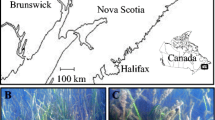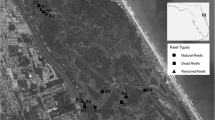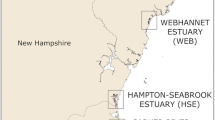Abstract
Marine foundation species have strong effects on sympatric species, but the strength may vary along environmental gradients. Climate change is shifting the distribution and magnitude of environmental gradients, making identification of when and where foundation species effects occur necessary for effective management. We reviewed existing work to identify expected mechanisms by which seagrass affect suspension feeding bivalves, then tested whether these effects shifted across estuarine conditions for two species of oysters (native Ostrea lurida and non-native Crassostrea gigas) grown in and out of eelgrass (Zostera marina) at six estuarine sites in Washington state. Hypothesized mechanisms of eelgrass influence include reduced predation pressure, reduced or altered food availability, and amelioration of environmental (pH) stress. We analyzed oyster survival, shell and tissue growth, shell strength, and stable isotope (SI) and fatty acid (FA) biomarkers. Oyster survival was > 20% lower in eelgrass at lower-estuary sites, but not up-estuary sites. Both species grew faster in eelgrass at one low-estuary (higher pH) site, but not elsewhere. Shell strength in eelgrass increased by 21.1% for native but decreased by 12.6% for non-native oysters. FA and SI biomarkers only differed in eelgrass at one site but correlated significantly to growth among individuals. No measurement showed a consistent response to eelgrass across estuarine conditions and taxa, and responses were often opposite of expectations based on published literature. These results have important implications for management and restoration of oysters in areas with eelgrass.





Similar content being viewed by others
References
Allen, B.J., and S.L. Williams. 2003. Native eelgrass Zostera marina controls growth and reproduction of an invasive mussel through food limitation. Marine Ecology Progress Series 254: 57–67.
Altieri, A.H., B.R. Silliman, M.D. Bertness, and Associate Editor: Marcel Holyoak, and Editor: Donald L. DeAngelis. 2007. Hierarchical organization via a facilitation cascade in intertidal cordgrass bed communities. The American Naturalist 169: 195–206.
Attrill, M.J. 2002. A testable linear model for diversity trends in estuaries. Journal of Animal Ecology 71 (2): 262–269.
Bates, D., M. Maechler, B. Bolker, and S. Walker. 2015. Fitting linear mixed-effects models using lme4. Journal of Statistical Software 67: 1–48.
Baumann, H., and E.M. Smith. 2017. Quantifying metabolically driven pH and oxygen fluctuations in US nearshore habitats at diel to interannual time scales. Estuaries and Coasts.
Bible, J., K.R. Griffith, and E. Sanford. 2017. Inducible defenses in Olympia oysters in response to an invasive predator. Oecologia 183 (3): 809–819.
Bologna, P.A.X., and K.L. Heck. 1999. Differential predation and growth rates of bay scallops within a seagrass habitat. Journal of Experimental Marine Biology and Ecology 239 (2): 299–314.
Borges, A., and G. Abril. 2011. Carbon dioxide and methane dynamics in estuaries. Treatise on estuarine and coastal science. Biogeochemistry 5: 119–161.
Budge, S.M., E. Devred, M.-H. Forget, V. Stuart, M.K. Trzcinski, S. Sathyendranath, and T. Platt. 2014. Estimating concentrations of essential omega-3 fatty acids in the ocean: Supply and demand. ICES Journal of Marine Science 71 (7): 1885–1893. https://doi.org/10.1093/icesjms/fsu003.
Buhle, E.R., and J.L. Ruesink. 2009. Impacts of invasive oyster drills on Olympia oyster (Ostrea lurida Carpenter 1864) recovery in Willapa Bay, Washington, United States. Journal of Shellfish Research 28 (1): 87–96.
Callaway, R.M., R.W. Brooker, P. Choler, Z. Kikvidze, C.J. Lortie, R. Michalet, L. Paolini, F.I. Pugnaire, B. Newingham, E.T. Aschehoug, C. Armas, D. Kikodze, and B.J. Cook. 2002. Positive interactions among alpine plants increase with stress. Nature 417 (6891): 844–848.
Carroll, J.M., and B.J. Peterson. 2013. Ecological trade-offs in seascape ecology: Bay scallop survival and growth across a seagrass seascape. Landscape Ecology 28 (7): 1401–1413.
Chamberlain, S.A., J.L. Bronstein, and J.A. Rudgers. 2014. How context dependent are species interactions? Ecology Letters 17 (7): 881–890.
Cloern, J.E., A.D. Jassby, T.S. Schraga, E. Nejad, and C. Martin. 2017. Ecosystem variability along the estuarine salinity gradient: Examples from long-term study of San Francisco Bay. Limnology and Oceanography 62 (S1): S272–S291.
Dayton, P. K. 1972. Toward an understanding of community resilience and the potential effects of enrichments to the benthos at McMurdo Sound, Antarctica. Proceedings of the Colloquium on Conservation Problems in Antarctica, 81–95.
de Boer, W.F. 2007. Seagrass–sediment interactions, positive feedbacks and critical thresholds for occurrence: A review. Hydrobiologia 591 (1): 5–24.
Doi, H., F. Akamatsu, and A.L. González. 2017. Starvation effects on nitrogen and carbon stable isotopes of animals: An insight from meta-analysis of fasting experiments. Royal Society Open Science 4: 170633.
Duarte, C.M., Esther Benavent, and Maria del Carmen Sanchez. 1999. The microcosm of particles within seagrass Posidonia oceanica canopies. Marine Ecology Progress Series 181: 289–295.
Ellison, A.M., M.S. Bank, B.D. Clinton, E.A. Colburn, K. Elliott, C.R. Ford, D.R. Foster, B.D. Kloeppel, J.D. Knoepp, G.M. Lovett, J. Mohan, D.A. Orwig, N.L. Rodenhouse, W.V. Sobczak, K.A. Stinson, J.K. Stone, C.M. Swan, J. Thompson, B. Von Holle, and J.R. Webster. 2005. Loss of foundation species: Consequences for the structure and dynamics of forested ecosystems. Frontiers in Ecology and the Environment 3: 479–486.
Galloway, A.W.., M.E. Eisenlord, M.N. Dethier, G.W. Holtgrieve, and M.T. Brett. 2014. Quantitative estimates of isopod resource utilization using a Bayesian fatty acid mixing model. Marine Ecology Progress Series 507: 219–232.
González-Ortiz, V., L.G. Egea, R. Jiménez-Ramos, F. Moreno-Marín, J.L. Pérez-Lloréns, T.J. Bouma, and F.G. Brun. 2014. Interactions between seagrass complexity, hydrodynamic flow and biomixing alter food availability for associated filter-feeding organisms. PLoS One 9: e104949.
Granata, T.C., T. Serra, J. Colomer, X. Casamitjana, C.M. Duarte, and E. Gacia. 2001. Flow and particle distributions in a nearshore seagrass meadow before and after a storm. Marine Ecology Progress Series 218: 95–106.
Grason, E.W., and E.R. Buhle. 2016. Comparing the influence of native and invasive intraguild predators on a rare native oyster. Journal of Experimental Marine Biology and Ecology 479: 1–8.
Gray, M. W., and C. J. Langdon. 2018. Ecophysiology of the Olympia oyster, Ostrea lurida, and Pacific oyster, Crassostrea gigas. Estuaries and Coasts 41: 521–535.
Hasegawa, N., M. Hori, and H. Mukai. 2008. Seasonal changes in eelgrass functions: Current velocity reduction, prevention of sediment resuspension, and control of sediment-water column nutrient flux in relation to eelgrass dynamics. Hydrobiologia 596: 387–399.
He, Q., and M.D. Bertness. 2014. Extreme stresses, niches, and positive species interactions along stress gradients. Ecology 95: 1437–1444.
He, Q., M.D. Bertness, and A.H. Altieri. 2013. Global shifts towards positive species interactions with increasing environmental stress. Ecology Letters 16: 695–706.
Hettinger, A., E. Sanford, T.M. Hill, A.D. Russell, K.N.S. Sato, J. Hoey, M. Forsch, H.N. Page, and B. Gaylord. 2012. Persistent carry-over effects of planktonic exposure to ocean acidification in the Olympia oyster. Ecology 93: 2758–2768.
Holsman, K.K., P.S. McDonald, and D.A. Armstrong. 2006. Intertidal migration and habitat use by subadult Dungeness crab Cancer magister in a NE Pacific estuary. Marine Ecology Progress Series 308: 183–195.
Irlandi, E.A., and C.H. Peterson. 1991. Modification of animal habitat by large plants: Mechanisms by which seagrasses influence clam growth. Oecologia 87: 307–318.
Jones, C.G., J.H. Lawton, and M. Shachak. 1997. Positive and negative effects of organisms as physical ecosystem engineers. Ecology 78: 1946–1957.
Judge, M.L., L.D. Coen, and K.L. Heck. 1993. Does Mercenaria mercenaria encounter elevated food levels in seagrass beds? Results from a novel technique to collect suspended food resources. Marine Ecology Progress Series 92: 141–150.
Ko, G.W.K., R. Dineshram, C. Campanati, V.B.S. Chan, J. Havenhand, and V. Thiyagarajan. 2014. Interactive effects of ocean acidification, elevated temperature, and reduced salinity on early-life stages of the Pacific oyster. Environmental Science & Technology 48: 10079–10088.
Koweek, D.A., R.C. Zimmerman, K.M. Hewett, B. Gaylord, S.N. Giddings, K.J. Nickols, J.L. Ruesink, J.J. Stachowicz, Y. Takeshita, and K. Caldeira. 2018. Expected limits on the ocean acidification buffering potential of a temperate seagrass meadow. Ecological Applications 28: 1694–1714.
Langdon, C.J., and R.I.E. Newell. 1990. Utilization of detritus and bacteria as food sources by two bivalve suspension-feeders, the oyster Crassostrea virginica and the mussel Geukensia demissa. Marine Ecology Progress Series 58: 299–310.
Lebreton, B., P. Richard, R. Galois, G. Radenac, C. Pfléger, G. Guillou, F. Mornet, and G. Blanchard. 2011. Trophic importance of diatoms in an intertidal Zostera noltii seagrass bed: Evidence from stable isotope and fatty acid analysis. Estuarine, Coastal and Shelf Science 92: 140–153.
Lowe, A.T., A.W.E. Galloway, J.S. Yeung, M.N. Dethier, and D.O. Duggins. 2014. Broad sampling and diverse biomarkers allow characterization of nearshore particulate organic matter. Oikos 123: 1341–1354.
MacArthur, R.H. 1964. Environmental factors affecting bird diversity. American Naturalist 98: 387–397.
McDevitt-Irwin, J., J.C. Iacarella, and J.K. Baum. 2016. Reassessing the nursery role of seagrass habitats from temperate to tropical regions: A meta-analysis. Marine Ecology Progress Series 557: 133–143.
Muller-Navarra, D.C., M.T. Brett, A.M. Liston, and C.R. Goldman. 2000. A highly unsaturated fatty acid predicts carbon transfer between primary producers and consumers. Nature 403: 74–77.
Nakaoka, M. 2000. Nonlethal effects of predators on prey populations: Predator-mediated change in bivalve growth. Ecology 81: 1031–1045.
Nelson, T.A., and J.R. Waaland. 1997. Seasonality of eelgrass, epiphyte, and grazer biomass and productivity in subtidal eelgrass meadows subjected to moderate tidal amplitude. Aquatic Botany 56: 51–74.
Newton, J.A., and R.A. Horner. 2003. Use of phytoplankton species indicators to track the origin of phytoplankton blooms in Willapa Bay, Washington. Estuaries 26: 1071.
Nielsen, K., J. Stachowicz, H. Carter, K. Boyer, M. Bracken, F. Chan, F. Chavez, K. Hovel, M. Kent, K. Nickols, J. Ruesink, J. Tyburczy, and S. Wheeler. 2018. Emerging understanding of the potential role of seagrass and kelp as an ocean acidification management tool in California. Oakland: California Ocean Science Trust.
Odum, W.E. 1984. Dual-gradient concept of detritus transport and processing in estuaries. Bulletin of Marine Science 35: 510–521.
Oksanen, J., F. Guillaume Blanchet, R. Kindt, P. Legendre, P.R. Minchin, R.B. O’Hara, G.L. Simpson, P. Solymos, M.H.H. Stevens, and H. Wagner. 2013. R package version 2.0–8. Page Vegan: Community Ecology Package.
Orth, R.J., K.L. Heck, and J. van Montfrans. 1984. Faunal communities in seagrass beds: A review of the influence of plant structure and prey characteristics on predator: Prey relationships. Estuaries 7: 339–350.
Pernet, F., R. Tremblay, L. Comeau, and H. Guderley. 2007. Temperature adaptation in two bivalve species from different thermal habitats: Energetics and remodelling of membrane lipids. Journal of Experimental Biology 210: 2999–3014.
Peterson, B.J., and B. Fry. 1987. Stable isotopes in ecosystem studies. Annual Review of Ecology and Systematics 18 (1): 293–320.
Pinheiro, J., D. Bates, S. DebRoy, D. Sarkar, and R Core Team. 2017. nlme: Linear and Nonlinear mixed effects models. R package version 3.1-137.
R Core Team. 2013. R: A language and environment for statistical computing. Vienna: R Foundation for Statistical Computing.
Reusch, T.B.H. 1998. Differing effects of eelgrass Zostera marina on recruitment and growth of associated blue mussels Mytilus edulis. Marine Ecology Progress Series 167: 149–153.
Reusch, T.B.H., and S.L. Williams. 1999. Macrophyte canopy structure and the success of an invasive marine bivalve. Oikos 84: 398–416.
Richards, M.G., M. Huxham, and A. Bryant. 1999. Predation: A causal mechanism for variability in intertidal bivalve populations. Journal of Experimental Marine Biology and Ecology 241: 159–177.
Richoux, N.B., and R.T. Ndhlovu. 2015. Temporal variability in the isotopic niches of rocky shore grazers and suspension-feeders. Marine Ecology 36: 1045–1059.
Ruesink, J.L. 2016. Epiphyte load and seagrass performance are decoupled in an estuary with low eutrophication risk. Journal of Experimental Marine Biology and Ecology 481: 1–8.
Ruesink, J.L., G.C. Roegner, B.R. Dumbauld, J.A. Newton, and D.A. Armstrong. 2003. Contributions of coastal and watershed energy sources to secondary production in a Northeastern Pacific estuary. Estuaries 26: 1079–1093.
Ruesink, J., S. Yang, and Alan C. Trimble. 2015. Variability in carbon availability and eelgrass (Zostera marina) biometrics along an estuarine gradient in Willapa Bay, WA, USA. Estuaries and Coasts: 1–10.
Taipale, S.J., M.J. Kainz, and M.T. Brett. 2011. Diet-switching experiments show rapid accumulation and preferential retention of highly unsaturated fatty acids in Daphnia. Oikos 120: 1674–1682.
Timmins-Schiffman, E., W.D. Coffey, W. Hua, B.L. Nunn, G.H. Dickinson, and S.B. Roberts. 2014. Shotgun proteomics reveals physiological response to ocean acidification in Crassostrea gigas. BMC Genomics 15: 951.
Valdez, S.R., B. Peabody, B. Allen, B. Blake, and J.L. Ruesink. 2017. Experimental test of oyster restoration within eelgrass. Aquatic Conservation: Marine and Freshwater Ecosystems 27: 578–587.
Wahl, M., S. Schneider Covachã, V. Saderne, C. Hiebenthal, J.D. Müller, C. Pansch, and Y. Sawall. 2018. Macroalgae may mitigate ocean acidification effects on mussel calcification by increasing pH and its fluctuations. Limnology and Oceanography 63: 3–21.
Waldbusser, G.G., B. Hales, C.J. Langdon, B.A. Haley, P. Schrader, E.L. Brunner, M.W. Gray, C.A. Miller, and I. Gimenez. 2015. Saturation-state sensitivity of marine bivalve larvae to ocean acidification. Nature Climate Change 5: 273–280.
Waldbusser, G.G., M.W. Gray, B. Hales, C.J. Langdon, B.A. Haley, I. Gimenez, S.R. Smith, E.L. Brunner, and G. Hutchinson. 2016. Slow shell building, a possible trait for resistance to the effects of acute ocean acidification. Limnology and Oceanography. 61 (6): 1969–1983.
Wilkie, E.M., and M.J. Bishop. 2012. Differences in shell strength of native and non-native oysters do not extend to size classes that are susceptible to a generalist predator. Marine and Freshwater Research 63: 1201–1205.
Winder, M., J. Carstensen, A.W.E. Galloway, H.H. Jakobsen, and J.E. Cloern. 2017. The land–sea interface: A source of high-quality phytoplankton to support secondary production. Limnology and Oceanography 62: S258–S271.
Wright, J.M., L.M. Parker, W.A. O’Connor, M. Williams, P. Kube, and P.M. Ross. 2014. Populations of Pacific oysters Crassostrea gigas respond variably to elevated CO2 and predation by Morula marginalba. The Biological Bulletin 226: 269–281.
Zuur, A.F., E.N. Ieno, N. Walker, A.A. Saveliev, and G.M. Smith. 2009. Mixed effects models and extensions in ecology with R. New York: Springer.
Acknowledgments
This work could not have been completed without the field and lab assistance of A. Lee, M. Payne, J. Aspée, H. Hayford, S. Von Reis, P. Stamp, and A. Trimble. We thank B. Taylor and Taylor Shellfish for providing oysters and the Padilla Bay National Estuarine Research Reserve (NERR) staff for field and logistical support. M. Dethier, C. Gross, and M. Turner provided valuable feedback on the manuscript. This work was authorized by Washington Fish and Wildlife Shellfish transfer permit no. 15-1105.
Funding
Funding for this research was provided by the Padilla Bay NERR Assistantship and Washington Department of Natural Resources.
Author information
Authors and Affiliations
Corresponding author
Additional information
Communicated by Henrique Cabral
Rights and permissions
About this article
Cite this article
Lowe, A.T., Kobelt, J., Horwith, M. et al. Ability of Eelgrass to Alter Oyster Growth and Physiology Is Spatially Limited and Offset by Increasing Predation Risk. Estuaries and Coasts 42, 743–754 (2019). https://doi.org/10.1007/s12237-018-00488-9
Received:
Revised:
Accepted:
Published:
Issue Date:
DOI: https://doi.org/10.1007/s12237-018-00488-9




